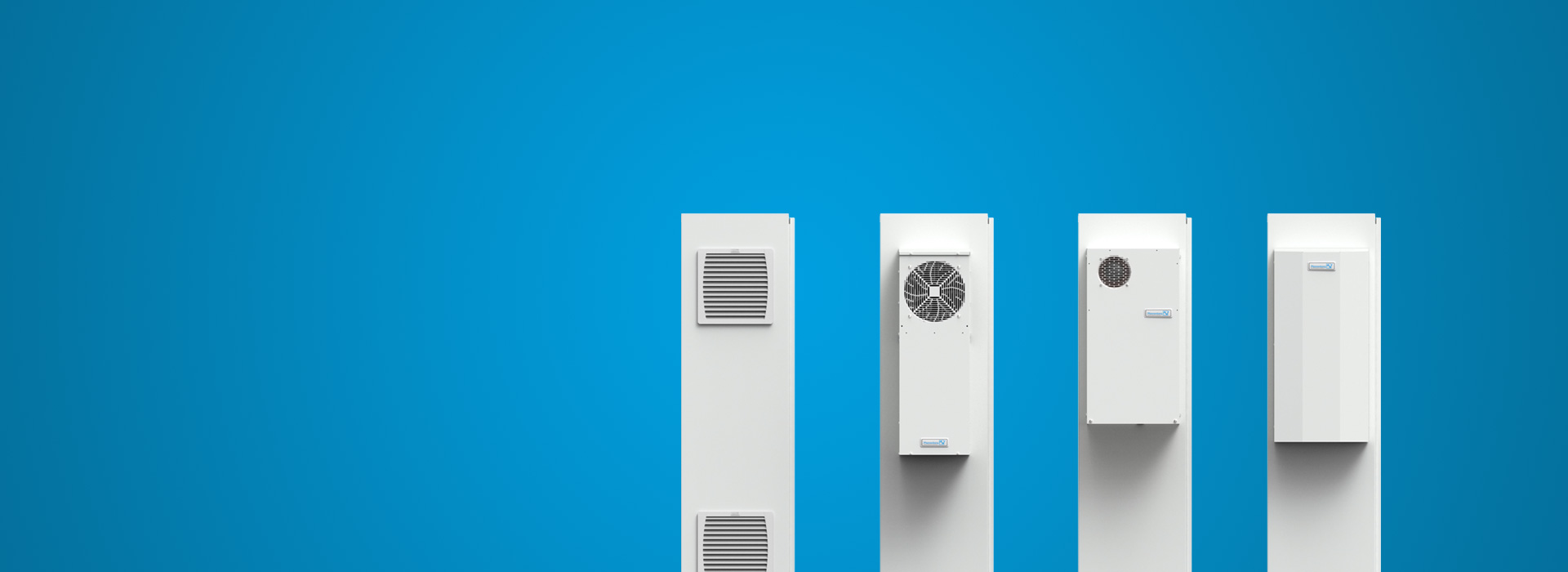Determining the correct thermal management products for your application.
It is important to understand the types of cooling methos available and the how the ambient conditions may effect the product chosen. Choosing the wrong method may lead to a solution that is undersized or oversized, or fails due to being specified for incompatible ambient conditions.
The use of louvers or grills with filters (see PFA Exhaust Filters) can be effective when the amount of heat being removed from your enclosure is minimal. This method usually provides less of a cooling effect than is necessary with today's components.

If the installation will be in a clean, non-hazardous environment with an acceptable ambient (outside the enclosure) temperature range, a simple forced-air cooling system utilizing outside air is usually adequate. Combined with an air filter, such devices generally meet the heat removal needs of typical electronic equipment and many electrical applications. An example of forced convection air cooling is Filterfans.
When can Filterfans be used for Forced Convection Cooling?
- If the ambient temperature is always lower than the temperature required in the electrical enclosure, then Filterfans represent an economical solution for thermal management of electrical enclosures.
- Use Filterfans to force the surrounding air into the electrical enclosure, so that slight overpressure builds up inside the enclosure.
- The surrounding air enters the electrical cabinet exclusively via the Filterfans, which ensures that it is filtered.
- Install the Filterfans in the lower third of the electrical enclosure and the exhaust filter as close to the top as possible. This assists the natural convection of the air and avoids hot spots within the enclosure.

In harsh environments involving high temperatures, wash-down requirements, heavy particulate matter or the presence of chemicals capable of damaging components (NEMA 4 of 12 environments), ambient air must be kept out of the enclosure. Closed-loop cooling consists of two separate circulation systems. One system seals out the ambient air, cooling and re-circulating clean, cool air throughout the enclosure. The second system uses ambient air or water to remove and discharge the heat. Example of closed-loop cooling equipment employed with electronics and process controls are cooling units and heat exchangers.
When are cooling units necessary?
- If cooling cannot be accomplished be the outside air.
- If the temperature required inside the electrical cabinet should be equal to or lower than the ambient temperature.
- If the ambient air is strongly contaminated with oil or conductive dust.
- When higher ingress protection is required (Type rating).
- Ensure a good supply of air intake ad outtake from the external circuit of the cooling unit, so that thermal energy can be transferred to the surroundings.
- The lowest temperature inside the enclosure may not necessarily be the best. The 95 F (35 C) preset by Pfannenberg represents a good compromise between service life and the accumulation of condensation.

When should air to air heat exchangers be used?
- If the panel temperature is allowed to be higher than the maximum ambient temperature.
- If vapors, particles or other foreign materials in the environment that must be allowed to penetrate the enclosure.
- Important for air to air heat exchangers: Air to air units have performances that are rated on the difference in temperature between the ambient air and enclosure temperature. This makes the solution ideal for equipment that can take high temperatures or systems in environments with existing climate cooling.
When should air to water heat exchangers be used?
- If a chilled water supply is available.
- If the ambient air cannot be used to provide cooling.
- If a very high IP class is required (up to IP 65).
- If a maintenance-free cooling solution is desired.
- If looking for an energy efficient "green" solution.

.svg)

